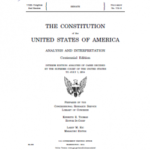Students create art works based on an examination of the language of the Constitution and the personal connections they make. These art works will incorporate words, illustrations, and mixed media images.
This lesson can be adapted for different grade levels. High school students can use an abridged version of the U.S. Constitution. Elementary and middle school students can use the Preamble, or introduction, to the Constitution.
How a Bill Becomes a Law – Clean Water Act of 1972
The Federal Water Pollution Control Act, commonly known as the Clean Water Act, was originally passed in 1948. By 1972, Congress had voted on an amended version of the law that included the expansion of regulations to prevent pollution of the nation’s waterways. In this lesson, students consider how the Clean Water Act of 1972 became a law. They identify key moments in the evolution of this bill including its path in Congress, its veto by President Nixon and its eventual enactment. Preparing and organizing information, students interpret these key events and share them in a storyboard presentation. While intended for 8th grade students, the lesson can be adapted for other grade levels.
Constitution of the United States of America: Analysis and Interpretation

Popularly known as Constitution Annotated, this Senate Document encompasses the U.S. Constitution and analysis and interpretation of it, with in-text annotations of cases decided by the Supreme Court of the United States. What began as an inclusion of the 1911 Senate Manual, is now almost 3,000 pages, and references more than 6,000 Supreme Court cases. The online version is updated regularly as new Supreme Court cases are decided. You can search or browse Constitution Annotated.